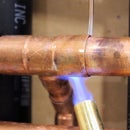Introduction: The ULTIMATE Leaky Copper Pipe Fix Guide
Welcome back to another article/video!
TOOLS:
Pipe dope I used: https://amzn.to/2IEasNp
Deburring pen: https://amzn.to/2IEasNp
Sharkbite depth gauge & deburring tool: https://amzn.to/2IEasNp
Step 1: 8 Ways to Fix a Leaky Copper Pipe
What’s up guys and welcome back to another article, in this article I’ll be showing you 8 ways to repair a copper pipe in the event of a burst due to freezing in winter, an accidental perforation or a simple pinhole due to corrosion.
Repairing a copper pipe could seem intimidating, but it’s super easy to do. Some of the methods I use in this video are code and some aren’t. Most times when something like this occurs, having it repaired by a certified plumber doesn’t always happen the same day, and, we all know that going without water is easier said than done.
So if you wanna temporarily stop the leak to be able to keep using water until a permanent repair could be arranged, here are 8 easy ways to get it done yourself:
Step 2: 2 Couplings and a Piece of Pipe
1/2" soldered couplings: https://amzn.to/2EwxSzV
1/2" repair coupling: https://amzn.to/2VkLNPh
Starting off with number 1: Using 2 couplings and a piece of pipe. This is by far the most common and up to code way of repairing a leaky copper pipe but requires some soldering. This should be your first go-to method for fixing a burst, perforation or pinhole in any case. To do it, all you need is 2 couplings the same size as the pipe, and a piece of pipe. If your water isn’t already shut off, go ahead and close it before starting the fix. Cut out the damaged area using a pipe cutter and deburr the inside of the pipe before assembling everything together, you could either use a dedicated pencil reamer like this one or you could simply use a utility knife to get the pipe back to its original size. If for whatever reason the pipes don’t have any play in them like this, you’ll need what they call a repair coupling which doesn’t have a stopper in it like normal couplings would. This allows for you to slip it on the pipe as such to be able to fit the new piece of pipe in place. Once you got it in place, pull the coupling back onto the pipe, ensuring that both pipes meet in the middle of the coupling, then proceed to soldering. If you’re unfamiliar with soldering, I have an easy to follow, step by step guide on how to do so, this video helped out thousands of people learn how to solder just after watching it 1 time, so I’ll put the link right here (How to solder) for you to watch it. Once you are done, wipe the excess flux and test it to make sure it doesn’t leak.
Step 3: Fix With Compression Fittings
1/2" compression fittings: https://amzn.to/2EctzZo
Number 2: is using compression couplings. This has to be the most user-friendly way of permanently repairing a leak for a DIYer. These fittings are made out of 3 components, the fitting, a sleeve, and a retainer nut. When the retainer nut is tightened, the sleeve is squeezed between it, the fitting and the pipe, making for a very secure and leak free joint. To install them, cut out the damaged area using a pipe cutter and ream the inside of the pipe before assembling everything together, you could either use a dedicated pencil reamer like this one, or you could simply use a utility knife to get the pipe back to its original size. You’ll need 2 wrenches to tighten these but before doing that, make sure to apply some pipe dope on the sleeve, this’ll ease the tightening process and act as a sealer. One thing that makes compression fittings shine, is that they can be installed on a leaking pipe, making it the 2nd choice on the list.
Step 4: Sharkbite Slip Coupling
1/2" Sharkbite slip coupling: https://amzn.to/2tGegDg
Number 3, is using a Sharkbite slip coupling. These fittings are good if you’re unfamiliar with soldering and prefer not taking any chances. They’re super easy to use and don’t require as many skills or tools to install them such as a soldering kit or crimpers. To install one, shut the water off like usual, use the fitting itself to mark where the cuts need to be made and cut using a pipe cutter. Deburr the inside and outside of the pipe. If you don’t have these dedicated tools, you could use a sharp utility knife for the inside, and a file for the outside. After, identify the Slip-end of the fitting and insert it onto the pipe until it clears the other end and use an adjustable wrench to push it in till both marks are visible and the repair is done. What’s nice about these Sharkbite fittings is that they also work on PEX and CPVC and don’t require and glue or soldering skills. This method is code approved if installed correctly.
Step 5: The KIBOSH Emergency Pipe Repair Clamp
1/2" Kibosh emergency pipe repair: https://amzn.to/2IEynwd
Number 4: is using a Kibosh Emergency Pipe Repair Clamp. I’ve already done a review of this tool on my channel and here’s the link for those who are interested in watching it. The Kibosh is an elegant device that’ll temporarily repair a leaking pipe in under 5 seconds with no skills required. It’s also made from non-toxic materials so it could be left on a leaking pipe for days without contaminating your potable water. Giving you a longer time frame to arrange for a proper repair. To install it on a leaking pipe, you need to first identify what size pipe you are dealing with and choose the appropriate clamp, and clamp it on, it’s literally that simple. It also works on steel, CPVC, PEX and Polybutelyne pipes which covers most residential and commercial systems around the world. The clamp could be reused as many times as needed, making it the most cost-effective pipe repair you can get. Since this is a temporary fix, they aren’t considered code as they must be removed for the pipe to be fixed the proper way.
Step 6: Patch It Up With Solder
Small roll of lead-free solder: https://amzn.to/2ExrAA2
Number 6: Soldering the hole shut. If there’s a small pinhole that appeared on your waterline, you might just be able to solder it shut to keep using your water. The first thing you need to do is shut main water valve, and make sure there’s no more water in the pipe by draining it from the lowest point in the house. Then, clean the pipe using an abrasive pad, add some flux and slowly heat the pipe, you’ll see the flux start to change color, go ahead and add some solder onto the hole, it should block it off and allow you to use your water until a plumber can fix it. This fix isn’t code approved.
Step 7: Copper Wire for Big Bursts
Number 7, is using a copper wire: If you have a bigger burst such as this, just adding some solder won’t do the job seeing the gap is too big to fill up. Get yourself some electric wire and clean it just like this. Like the previous trick, clean the damaged area with an abrasive such as a scotch pad or emery cloth. Then, tightly wrap it around the pipe like you see here and use some pliers to secure it in place. You could then solder it just like the first trick and it should seal the pipe temporarily. Although this method could get you outta trouble for a day or two, it is NOT code approved and should be fixed the correct way as soon as possible.
Step 8: Alfa Tape
Pipe repair tape: https://amzn.to/2H07YX8
Number 8: is using Alfa Tape. This tape is made from an advanced polymer that fuses itself when wrapped together tightly and can withstand over 100psi of pressure. It’s made with non-toxic materials and could be left on a potable water line for a quick repair if needed, although it’s not recommended. The only down side to using this tape is clearance, meaning, if you are trying seal a leak on a pipe that’s close to a wall, you won’t be able to use it due to the lack of space, which leads me to the next product which to me is the..
Step 9: Freeze Fix Epoxy Repair Kit
Epoxy Freeze fix kit: https://amzn.to/2Vobq1M
Number 9: is an epoxy putty called FREEZE FIX. This kit uses an epoxy saturated cloth that when applied, will seal a leak or burst on a pipe or on a fitting. To use it, first kneed the epoxy putty so that both part A and part B are properly mixed together. Then apply it on the burst as such while making sure to taper both extremities. Then, soak the cloth in water for about a minute and apply it around the putty while keeping tension on it at all times up until there’s none left and wait for everything to harden before opening the water. This kit is great for doing its job but is made with harsh chemicals such as the epoxy used to bond everything together and will come in contact with the water in the pipe. Unlike other pipe repair kits, this one won’t work if any water is leaking from the pipe so you’ll need to shut off the water and it could sometimes take a while to find. Something else I dislike is it could get messy and if left untouched could harden and be really hard to remove. This temporary fix is not code and should be removed promptly for a proper fix. In my personal experience, there are much better solutions on the market for getting a leak sealed or repaired, let’s move on.











